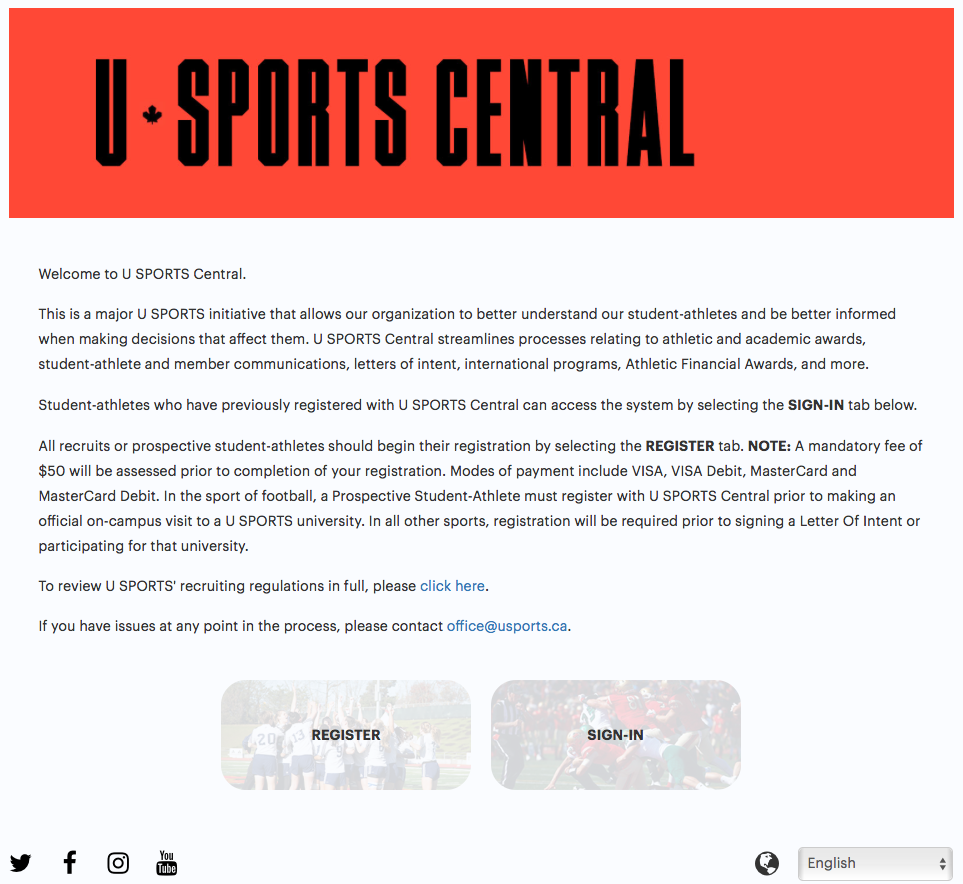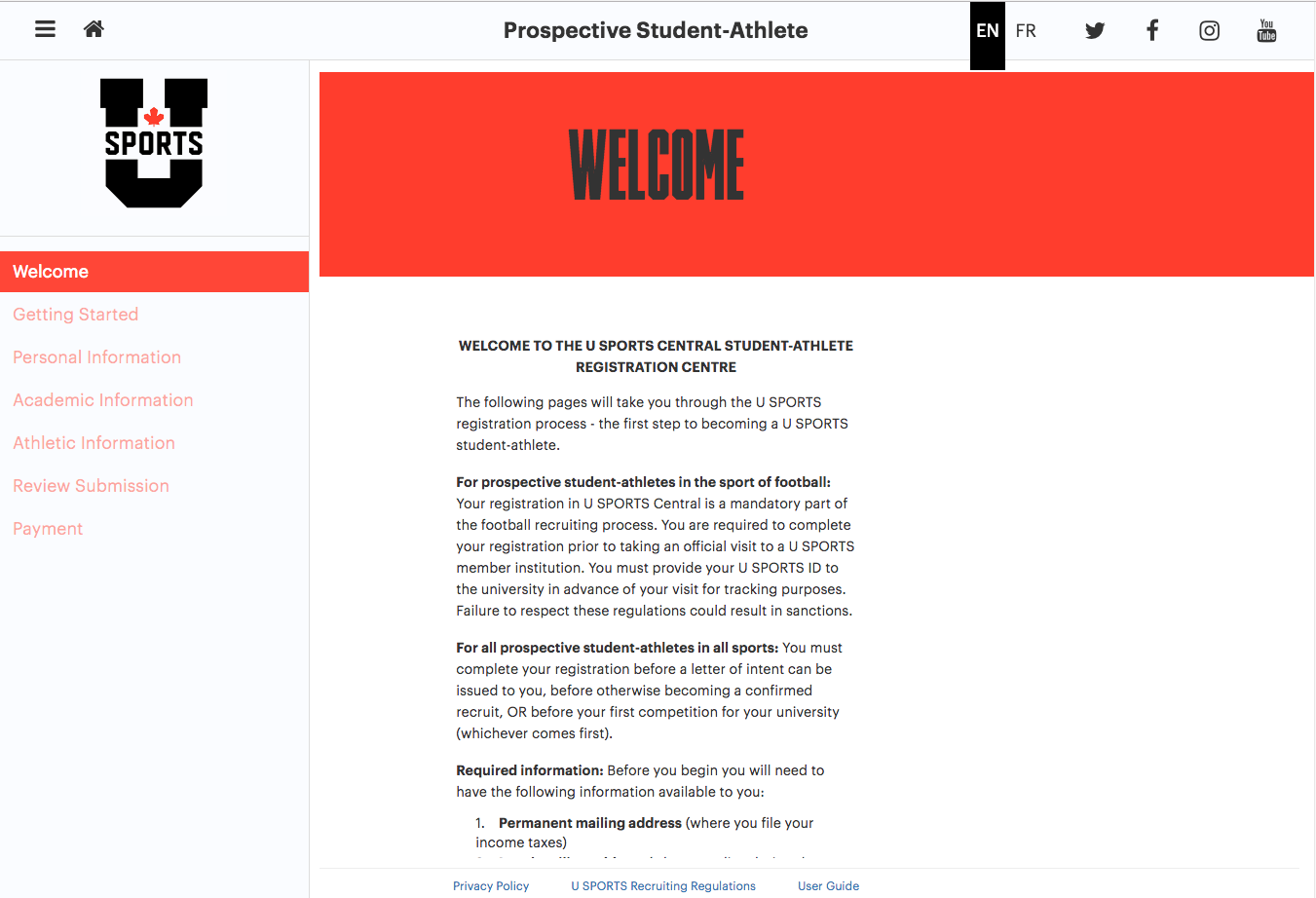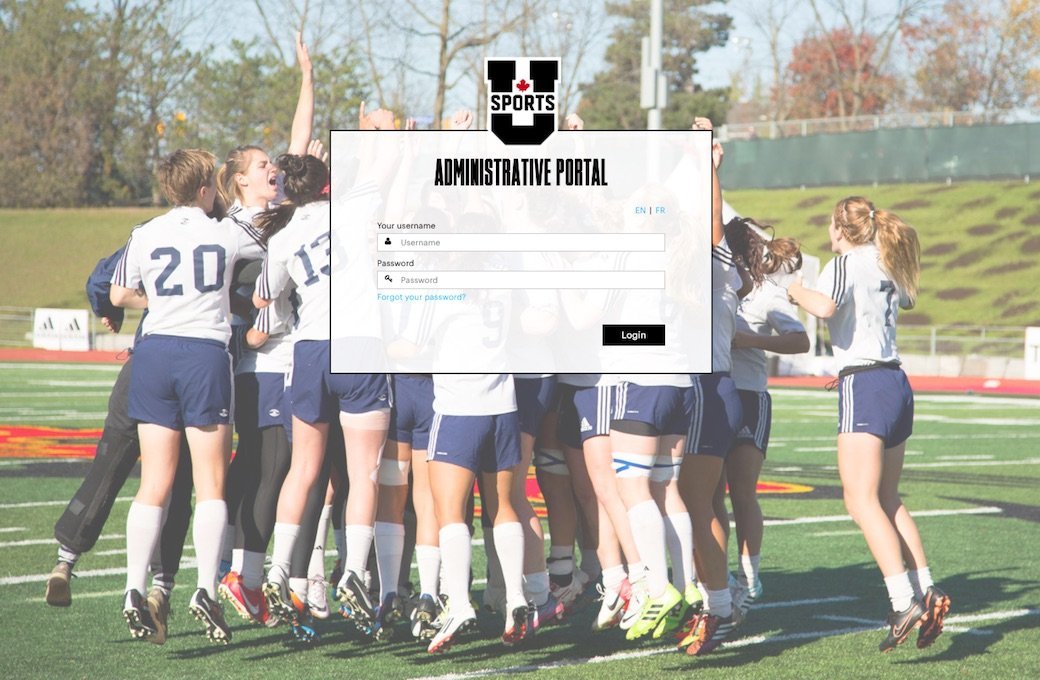Corporate
A large change continues at U SPORTS to standardize and centralize processes around athlete eligibility, providing benefits for both the national office and its 56 member schools.
The U SPORTS Central project began in January 2016, starting with football recruit visit tracking, and has since expanded to see all 14,000 U SPORTS student-athletes registered online, beginning with the 2017-18 season. Further work since then has led to additional paper processes being transferred to online, including the standardization of Eligibility Certificates and of Academic All-Canadian submissions in the fall of 2017. Perhaps most significantly, the issuing, tracking, and publicizing of Letters of Intent (LOIs) has also been transitioned from a paper-based system to U SPORTS Central.
As a result, an LOI registry that had historically been months out of date, and thus of very limited value to coaches and athletic department staff, is now accurate to within 48 hours. In addition, whereas LOIs might previously have been improperly signed or otherwise incomplete or incorrect, and such deficiencies only noticed when an issue arose, U SPORTS Central ensures that LOIs are done properly, or are not registered as complete.
Prospective U SPORTS student-athletes are required to register and pay a one-time mandatory $50 registration fee, which schools cannot cover for their student-athletes, prior to taking an official recruiting visit for the sport of football, or prior to becoming a confirmed recruit in any sport.
Furthermore, after a lengthy delay resulting from issues with the previously-used online platform, Athletic Financial Award submissions for 2015-16, 2016-17, and 2017-18 have now been completed on U SPORTS Central, and the results communicated to the membership.
At a very general level, it’s about enhancing the operations of the organization. We’re definitely an amateur sport organization, but we can be run more professionally to the benefit of our members, our conferences and our student-athletes. I think U SPORTS Central is a huge leap in the right direction as far as the improvement of what we actually do day-to-day.
Goldstein
Goldstein added that digitizing and standardizing Eligibility Certificates in particular has been a key goal.
“An example is our Eligibility Certificates – the documents that schools submit listing who’s allowed to play a given sport in a given season,” Goldstein said. “It’s a very important document, and it’s historically been collected by the national office by PDF or by fax, but it’s looked different depending on which school’s submitting it, both as far as the order of the information and the quantity of information, with some giving more, and some less. So there’s inconsistency. And when you’re trying to improve the operations of a business, standardization is a big thing. Our documents should look the same.

“Also, we’re collecting that information but we’re also submitting that information. So if we send a document to the CFL, for example, they want to know who played football in a given season so they can know who’s eligible for the draft. It’s one thing to send them a clean, easy-to-read document that’s consistent, that looks one way, and they can just receive it and use it, as opposed to scans of scans of scans…So it’s making it easier for them, as a valued partner of ours.”
It’s not just about making things look better visually, as Goldstein said this can also help prevent human errors and resolve eligibility disputes.
It’s not just about making things look better visually, as Goldstein said this can also help prevent human errors and resolve eligibility disputes.
“If there’s any sort of human error that’s totally justifiable or a human delay that’s justifiable, we’re entirely reliant on an individual and checking that person’s e-mail inbox, and at the same time, it’s being sent in by an individual, so all the same human error delays are risks on their end,” he said. “For such a critical document…if you’re at the national championship and there’s a dispute over whether someone should be allowed to play, you go to ‘Well, was he or she on the eligibility certificate?’ and instead of ‘Let’s have our staff member check her inbox to see what the last version she received was and have your staff member check his outbox to see what the last version he sent was,’ we, any of our staff who have the security clearance, can now go on an electronic system and say ‘At Oct. 18 at 2:59 p.m., the most recent version was uploaded, it was approved by the athletic director at this time and signed off by the registrar at that time.’
Are you a prospective U SPORTS student-athlete? Introducing the expanded U SPORTS Central! Click below for more information ? pic.twitter.com/MTCVTcOAg8
— U SPORTS (@USPORTSca) September 21, 2017
“And it’s just there. It’s accurate, it’s clean, there’s no debating it. If our staff member was sick when we needed to find that information, or on vacation, it doesn’t change anything. We can just find that information. So that’s a big, big deal, reducing and eliminating that human error and delay. ”
Beyond that, Goldstein said another key advantage of the new system is that it will make the data schools submit indexable and searchable, providing U SPORTS with information on where their athletes come from and letting them make data-based decisions.
“If we get PDFs from 56 schools about their sports, we can’t aggregate, collect or learn from that information. We get all of these documents that say exactly who’s eligible to compete in our sports in a given year, but if I say ‘What’s the average age of a student-athlete? How many student-athletes are from Montreal? How many are from Halifax? How many are Canadian citizens, how many aren’t citizens?’ With PDFs and faxes, we can’t know any of that; it’s hundreds of hours of manual reviewing, which would have been too much work to do on a consistent basis. With U SPORTS Central, that’s a quick query.
Security and privacy are massively important priorities for us. This is a huge change, and we’ve taken a lot of steps to make sure on the technical side that everything is top-notch in terms of security.
“Suddenly we’re much more knowledgeable about who our student athletes are, where they come from, how old they are. And this is just the critical basic information; we’re not collecting any more information than we ever used to, we can just actually use it and learn from it. So when a decision comes up, about a certain sport or an age issue or a citizenship issue or a regional issue, any of that stuff, we can actually have data, and I can’t tell you how important it is to have that data inform your decisions so it’s not just anecdotal.”

Of course, with storing that kind of data, there are potential concerns about student-athletes’ privacy. Goldstein said addressing that has been a key focus of the system, though.
“Security and privacy are massively important priorities for us. This is a huge change, and we’ve taken a lot of steps to make sure on the technical side that everything is top-notch in terms of security. And the permission settings are very clear. So, for example, Alberta athletic staff cannot see anything on a Calgary program…On all of that and the legal side, we’ve worked very hard to be as above-board as we possibly can be. And that easily remains the top priority, making sure that the security and privacy of that information is paramount.”
Goldstein said the idea isn’t to shift responsibility for eligibility, but to make eligibility submissions a simpler process.
“Nothing has changed fundamentally as far as our culture of eligibility. Our schools are still the ones responsible for the accuracy of the information and for submitting it. This just prepopulates fields, carries data over year-to-year so now they’ll be checking instead of inputting…And we’re trying to make it as transitional as possible for them, so the system can export into an Excel sheet, export into a PDF, whatever their internal process is.”
Goldstein said it’s important for U SPORTS to not just rush to digitize everything, but to do so in a careful and deliberate way that works for the members.
“It’s making sure that we’re adding the most significant processes we can as quickly as we can while getting it right. And what’s really important and what we’re learning is even if we understand a process generally, it’s important that the process maybe take a bit longer than we would have originally thought, that we speak to our members, that we ask them some of the nuances, some of the little things that maybe you wouldn’t understand just by getting a birds-eye view of what that process looks like, and then letting them test it out and say ‘This is great, but here’s a thing that’s going to take me 10 hours that if you made this switch it would take me one.’ And we’re trying to do that.”
He added that while this means more short-term work for many, it should reduce the workloads in the long term, and that schools have been quite supportive of the initiative.
“With any change this significant, it’s more work at the start. Our members are already extremely hard-working, extremely busy, and this is definitely more work for them, and they’ve been amazing about it. The feedback has been helpful, their patience level has been great. I think everyone understands where we’re getting to and the significance of it, and when there are challenges, they’ve been very honest and forthcoming and that’s helped us get better. Our members have been amazing about this. It’s a huge transformative change, it doesn’t work if they don’t buy in.”

University of Ottawa director of sport services Sue Hylland said she thinks this is a vital initiative for U SPORTS.
“We see it as a real positive. We jumped into it,” Hylland said. “I was part of the original group that recognized the importance of having something like this so that there were standard ways of standardizing processes that universities use. They’re submitting this information anyway, so how do we do it in an easier way?”
She said this was a needed change, and it’s already made significant progress.
“I think the foundation’s been set to make it easier and easier and easier as we go forward. The old days of paper submission, it was ridiculous. We’re way past that. They needed to get these things standardized or U SPORTS was going to fall behind the times. This stuff needs to be electronic. And I was also part of some of the discussions, the difficulties of getting everyone on side, but you know, you just have to start. You just have to keep moving. It’s a steady and sure approach; you keep moving, people get more comfortable, it gets better, and then before you know it, they don’t even realize there were any issues.”
Hylland said that data collection and standardization can pay huge benefits too. She’s optimistic that will benefit the schools as well as the national office, and that it will pay dividends for both down the road.
“The old way, we could never collect the data. The more data you have that’s true data, the more valuable your property gets. There’s so many ways with this data they’ll be able to build value with university sports, and from there, attract more and more partners when you start to see the breadth and depth of the data.”
Hylland was previously the president and CEO of the Canada Games. She said she saw the value of this kind of data in that job, and she expects it to be a great boon for U SPORTS.
The more data you have that’s true data, the more valuable your property gets. There’s so many ways with this data they’ll be able to build value with university sports, and from there, attract more and more partners when you start to see the breadth and depth of the data.
“You need to collect data to show the scale and scope of the property you’re working with, and I don’t think there’s ever been a good way. And the system that’s now set up with U SPORTS Central, it will add greater value as U SPORTS is out there talking to partners and trying to get television deals and trying to get sponsorship deals. All of those things help not only U SPORTS, they help the institutions…Once you have all this data, you can show sponsors the scale, scope and magnitude of the property you have, and it builds value and attracts partners.”
Overall, Hylland said her school has been quite pleased with how this change is going.
“We’re happy. We jumped in. We wanted to help and be part of the positive change. We saw what this could be…At the end of the day, I think it is a value-add thing. We’re all going to be better off for it as we go forwards.”
 Andrew has been covering university sports in Canada since 2005 at outlets such as The Queen's Journal, The CIS Blog, and Yahoo Canada, where he also served as the editor of the Canadian football blog 55-Yard Line. He has a Bachelor of Arts (Honours) degree from Queen's University with a major in history, and currently works as a staff writer and editor for Awful Announcing and The Comeback.
Andrew has been covering university sports in Canada since 2005 at outlets such as The Queen's Journal, The CIS Blog, and Yahoo Canada, where he also served as the editor of the Canadian football blog 55-Yard Line. He has a Bachelor of Arts (Honours) degree from Queen's University with a major in history, and currently works as a staff writer and editor for Awful Announcing and The Comeback.

